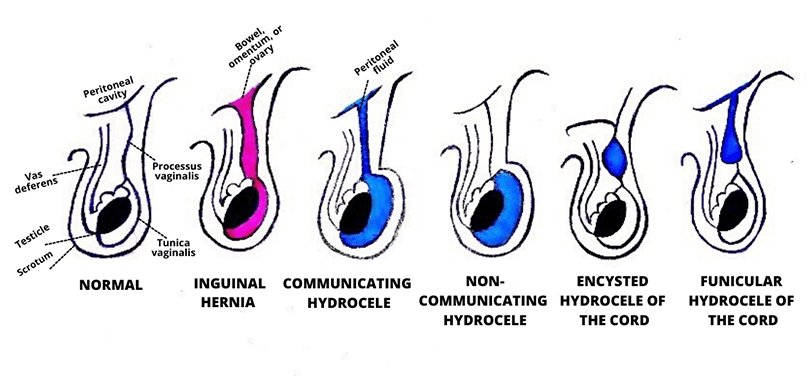Patient EducationDec | 30 | 2018
Hydrocele in Children: Causes and Symptoms
What is a hydrocele?
A hydrocele forms as a result of fluid collecting in the sac surrounding the testicles. Swelling occurs on one or both sides. Hydroceles are common in newborn boys. Premature infants are more likely than other babies to develop a hydrocele.
What causes hydroceles in children?
During pregnancy, testicles in males travel down from the abdomen (belly area) and into the scrotum. This downward motion creates a tunnel called the processus vaginalis, where the lining of the abdomen extends into the scrotum. Before birth, this tunnel usually closes by itself. A hydrocele occurs when the processus vaginalis does not close completely or when there is still fluid left around the testicle at the time of birth.
What are the different types of hydroceles?
There are 3 types of hydroceles:
- A non-communicating hydrocele occurs when there is no connection between the abdomen and the scrotum. In this case, fluid around the testicle is trapped but no new fluid enters the scrotum. The fluid usually will slowly go away by itself. This is not serious. One type of non-communicating hydrocele is called a reactive hydrocele. This can occur during childhood when trauma or infection causes scrotal inflammation (swelling of the scrotum).
- A communicating hydrocele occurs when the tunnel connecting the abdomen and the testicle does not close before birth. This allows fluid to pass in and out of the scrotum in both directions. Communicating hydroceles are more common in premature boys. They can affect the size of the scrotum, depending on the amount of fluid present. When your baby is straining or crying, fluid from the abdomen goes into the scrotum and makes it larger. When your baby is sleeping, the fluid goes back into the abdomen and the scrotum gets smaller. When the opening in the tunnel is large, other contents of the abdomen can enter the scrotum too, including the intestine. When this happens, that is an inguinal hernia.
- Spermatic cord hydrocele (also called hydrocele of the cord) is less common than a scrotal hydrocele. It refers to fluid collecting along the spermatic cord (the vessels and duct that go to and from the testes). There are two types of hydroceles of the cord:
- In an encysted hydrocele of the cord, there is fluid in the spermatic cord but no opening into the abdomen or scrotum. Fluid cannot pass through the tunnel from the abdomen or travel further down into the tunica vaginalis sac in the scrotum. Instead, the fluid sits in the spermatic cord. The body usually absorbs the fluid from there over time. This can take up to one year.
- A funicular hydrocele of the cord means that the processus vaginalis has not closed, so there is still a small passageway for fluid between the abdomen and the spermatic cord. Much like communicating scrotal hydroceles, the area of the cord changes in size when babies cry or lie down. A funicular hydrocele is more likely to require surgery.

What are the symptoms of a hydrocele in children?
Hydroceles can present in different ways:
- A smooth lump on one or both sides of the scrotum
- Painless swelling of the scrotum
- Fluctuating scrotum size (getting smaller at night and larger during activity)
Did you know…?
Teens and young adults can also develop hydroceles, though not as a result of development during pregnancy. Hydroceles in teens and young adults are non-communicating and are not connected to the abdomen. Instead, they are caused by an overproduction of fluid in the scrotum. These hydroceles usually go away over time. However, they can be a sign of something more serious, like a testicular tumor. If your teen or young adult has scrotal swelling, make an appointment to see a pediatric surgeon or urologist.
Related Pages
Type
Centers and Departments
Topics
Patient Resources
Patient Resources for Pediatric Surgery
Appointments and Referrals
Request an appointment or second opinion, refer a patient, find a doctor or view test results with MGfC's secure online services.

